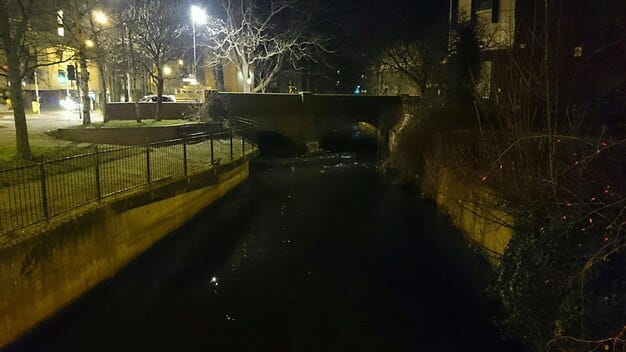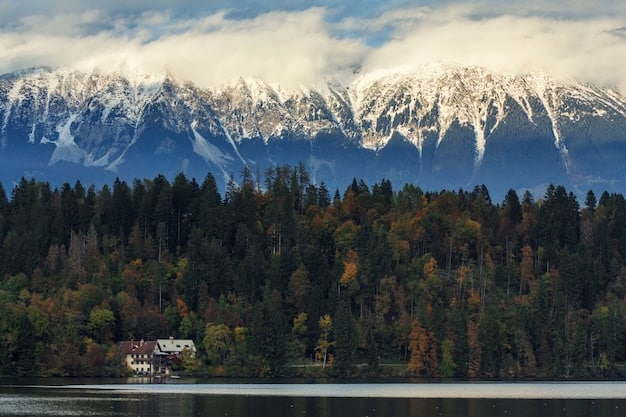The Impact of Location: How Setting Shapes International Crime Dramas

The Impact of Location: How Setting Shapes the Narrative in International Crime Dramas explores how geographical and cultural contexts significantly influence plot, character development, and thematic depth in crime storytelling.
The Impact of Location: How Setting Shapes the Narrative in International Crime Dramas extends far beyond providing a backdrop; it fundamentally shapes the story, influencing everything from character motivations to plot twists. Discover how these settings become integral to the narratives.
The pivotal role of setting in international crime dramas
International crime dramas captivate audiences with their intricate plots and compelling characters. However, one of the most critical, yet sometimes overlooked, elements is the setting. The location in which these stories unfold is more than just a backdrop; it’s a character in itself, influencing the narrative in profound ways.
By examining how different locales affect storytelling, we can gain a deeper appreciation for the complexities of these shows and understand why certain crime dramas resonate so strongly with viewers.

Cultural context and criminal behavior
The cultural context of a setting can significantly influence the type and nature of criminal behavior depicted in international crime dramas. Local customs, traditions, and social norms often play a crucial role in shaping the motives, methods, and consequences of criminal activities.
Different cultures have unique perspectives on justice, morality, and law enforcement, which can add layers of complexity to the storytelling and make the narratives more authentic and engaging.
Cultural norms and crime
Cultural norms can inadvertently create environments where certain types of crime are more likely to occur. For example, in some societies, honor killings or arranged marriages might be portrayed as cultural practices, while in others, they are seen as serious crimes. The way these actions are depicted in crime dramas can spark important conversations about cultural sensitivity and human rights.
Economic disparities
Economic disparities can also drive criminal behavior. In regions with high levels of poverty and unemployment, desperation can lead individuals to engage in theft, drug trafficking, or other illegal activities. Crime dramas set in these areas often highlight the social and economic factors that contribute to crime, providing a more nuanced understanding of the characters’ motivations.
- Exploring the impact of poverty on crime rates.
- Analyzing how wealth inequality drives specific types of criminal activity.
- Understanding the societal pressures that lead individuals to criminal behavior.
The cultural and economic backdrop of a location deeply influences the kinds of crimes that occur and how they are perceived, adding depth and realism to the narrative.
Geographical factors and criminal activity
Geographical factors, such as climate, terrain, and natural resources, play a significant role in shaping both the type and scale of criminal activities in international crime dramas. These elements can facilitate or hinder criminal operations, influencing how law enforcement agencies respond and adapt.
Understanding the interplay between geography and crime can enhance the realism and complexity of these narratives.

Urban landscapes
Urban landscapes, with their dense populations and complex infrastructure, often serve as breeding grounds for various types of crime. The anonymity of city life can make it easier for criminals to operate undetected, while the concentration of wealth and opportunities can create lucrative targets for theft and fraud. Crime dramas set in bustling metropolises often explore the challenges of policing these sprawling environments.
Rural settings
Rural settings, on the other hand, may present different types of criminal opportunities. Remote areas with limited law enforcement presence can be attractive to drug traffickers, smugglers, or those seeking to evade justice. The vastness and isolation of these landscapes can make it difficult for authorities to track and apprehend criminals.
Geography shapes the very nature of criminal activities, from the challenges of operating in urban environments to the unique opportunities found in rural settings.
Character development: Shaped by location
Location is not just a backdrop; it actively shapes the characters within international crime dramas. The environment in which they live and work influences their personalities, motivations, and the choices they make.
By exploring how characters are molded by their surroundings, we can better understand their actions and the overall narrative.
Local detectives
Local detectives are often deeply connected to their communities, possessing an intimate knowledge of the landscape, culture, and people. This connection can be both an asset and a liability, as they may face personal conflicts or moral dilemmas when investigating crimes that involve their friends, neighbors, or family members. The setting thus becomes an integral part of their identity and their approach to law enforcement.
Outsiders in a foreign land
Outsiders, such as foreign investigators or tourists, often find themselves grappling with unfamiliar customs, languages, and social norms. Their experiences in a new location can lead to significant personal growth or expose cultural biases and misunderstandings. Crime dramas that feature outsiders often use the setting to highlight cultural differences and explore themes of adaptation and assimilation.
- Analyzing how local detectives navigate their community ties.
- Examining the cultural clashes faced by foreign investigators.
- Understanding the personal transformations that occur through location.
The location in which characters operate shapes their identities and experiences, adding depth and complexity to their roles in the crime drama.
Symbolism and atmosphere: Setting the tone
The setting in international crime dramas often serves as a powerful symbol, conveying deeper meanings and creating a specific atmosphere. The visual and emotional impact of a location can enhance the storytelling, adding layers of interpretation and reinforcing the themes of the narrative.
By understanding the symbolic significance of different settings, viewers can gain a richer appreciation for the artistry and complexity of these shows.
Darkness and despair
Dark and gritty urban environments, such as rain-soaked alleys or dilapidated buildings, can symbolize corruption, decay, and moral ambiguity. These settings often reflect the darker aspects of human nature and the struggles of individuals living in marginalized communities. The visual contrast between light and shadow can underscore the tension and suspense of the narrative.
Beauty and danger
Beautiful but remote landscapes, such as snow-covered mountains or dense forests, can represent isolation, vulnerability, and the hidden dangers that lie beneath the surface. These settings may evoke a sense of awe and wonder, but also a feeling of unease and foreboding. The contrast between the beauty of the natural world and the brutality of human actions can create a powerful emotional impact.
Symbolism and atmosphere enhance emotional resonance, deepening the viewer’s connection to the story and its characters.
Impact on plot: Twists and turns
The location in international crime dramas is not just a backdrop but a catalyst for plot twists and turns. The unique characteristics of a setting can create opportunities for unexpected events, forcing characters to adapt and driving the narrative in new directions.
Exploring how location influences plot development can reveal the ingenuity and creativity of the writers and filmmakers behind these shows.
Restricted access
Locations with restricted access, such as private estates, government buildings, or underground tunnels, can present unique challenges for investigators. The need to navigate security measures, evade surveillance, or infiltrate restricted areas can add layers of complexity and suspense to the plot. These settings often become central to the unraveling of a criminal conspiracy.
Cultural misunderstandings
Cultural misunderstandings in unfamiliar locales can create unexpected twists and turns in the plot. Language barriers, cultural taboos, or differing legal systems can lead to miscommunications, false leads, or unintended consequences. Crime dramas that explore these themes often highlight the challenges of cross-cultural investigations and the importance of cultural sensitivity.
- Analyzing how restricted locations create plot challenges.
- Examining the effects of cultural misunderstandings on investigations.
- Understanding the ways in which setting impacts the narrative flow.
The setting’s unique attributes can change the course of the plot, keeping viewers engaged and invested in the unfolding drama.
Authenticity and realism: The sense of place
One of the key factors that make international crime dramas so compelling is their commitment to authenticity and realism. By accurately depicting the sights, sounds, and social dynamics of a particular location, these shows create a strong sense of place that draws viewers into the story.
Exploring how authenticity and realism contribute to the success of these dramas can reveal the importance of attention to detail and respect for cultural nuances.
Local talent
Using local actors, crew members, and consultants can help ensure that the portrayal of a setting is accurate and respectful. These individuals can provide valuable insights into the culture, customs, and language of the region, helping to avoid stereotypes or misrepresentations. The involvement of local talent can also add a layer of authenticity that resonates with viewers.
Real locations
Filming in real locations, rather than studio sets, can enhance the sense of realism and immersion. The use of actual streets, buildings, and landmarks can transport viewers to another world, making the story feel more immediate and believable. However, filming in real locations also presents challenges, such as logistical constraints, security concerns, and the need to respect local communities.
Authenticity helps viewers connect with the story on a deeper level, trusting the depiction of the environment and culture.
| Key Points | Brief Description |
|---|---|
| 🌍 Cultural Context | Local customs deeply shape criminal motivations. |
| 🏞️ Geographical Factors | Urban and rural settings influence crime types. |
| 🕵️ Character Development | Location molds detectives and outsiders. |
| 🎭 Plot Twists and Realism | Authenticity and location details enhance plot turns. |
Frequently Asked Questions (FAQ)
▼
Cultural context shapes the motives and consequences of criminal activities, adding depth. Differing views on justice and morality enhance storytelling by showcasing unique perspectives, making narratives authentic and intricate. These insights can impact the storyline greatly.
▼
Geography influences the type and scale of criminal behavior. Urban landscapes breed anonymity, while rural settings offer isolation for illicit activities. Law enforcement agencies adapt based on geographical conditions, enhancing realism and complexity in narratives.
▼
Location profoundly shapes characters, influencing their personalities and motivations. Local detectives, deeply rooted in their communities, and outsiders facing unfamiliar norms, undergo notable transformations based on the environment, enriching their stories.
▼
Yes, atmosphere created through setting significantly enhances the storytelling. Darkness symbolizes corruption, while remote beauty evokes isolation, amplifying emotional resonance. These scenic elements add layers to interpretation and strengthen the thematic depth greatly.
▼
Authenticity provides a vital sense of place, drawing viewers into the narrative. Accurate sights and social dynamics, achieved via local talent and true locations, add credibility. The overall realism ensures deeper emotional connection and trust for the series.
Conclusion
In conclusion, the impact of location: how setting shapes the narrative in international crime dramas is profound and multifaceted. By considering the cultural, geographical, and symbolic dimensions of a setting, filmmakers can create stories that are not only entertaining but also thought-provoking and deeply resonant.





